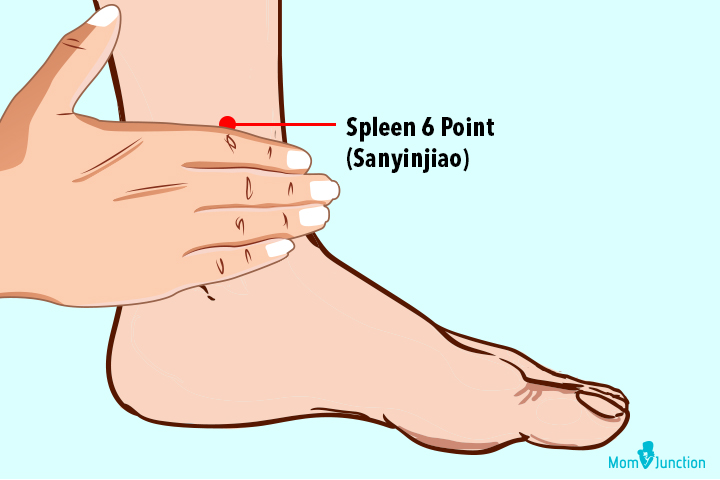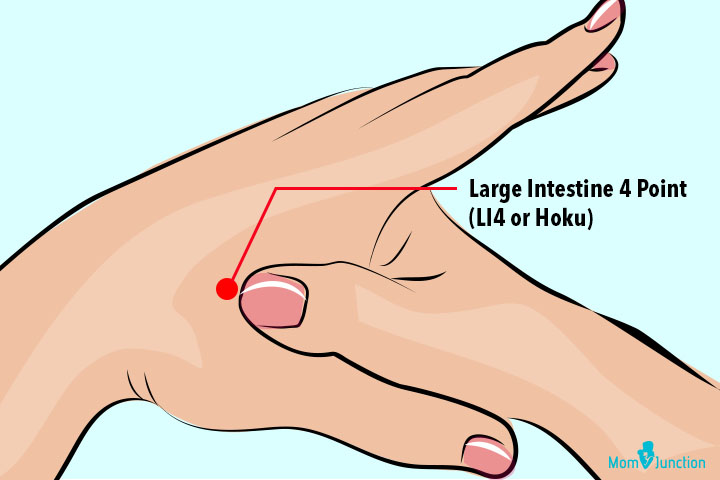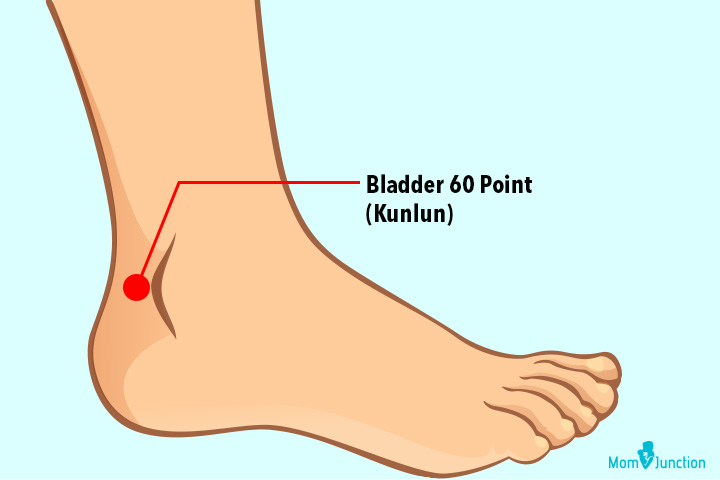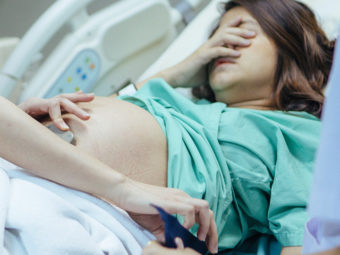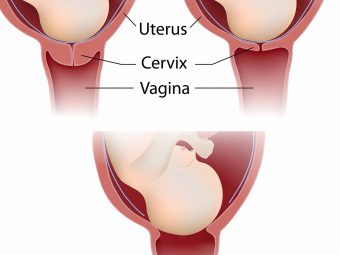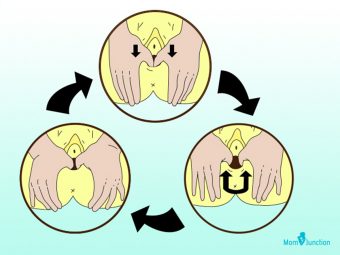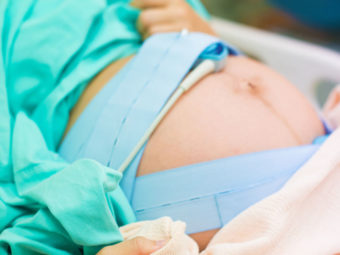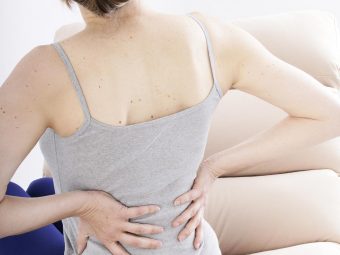
Image: MomJunction Design Team
Most women who are past their due dates may be apprehensive about going through medical induction of labor for natural childbirth. However, some might prefer trying conventional methods, such as pressure points to induce labor. Studies show that only about five percent of babies are delivered on the expected dates, while most of them are usually born a few weeks earlier or later than the due date (1). Hence it is alright to cross the 40th week mark of pregnancy. However, if you tend to have no signs of labor even after crossing the 42nd mark, you may consider trying acupressure. Go through this post as we reveal crucial details about the safety and effectiveness of using acupressure for labor induction.
What Is Acupressure?
Acupressure is an age-old practice from China. It works by stimulating different points on the body and maintaining the energy flow throughout the body, removing any blockages in the way.
Does Acupressure Help Labor?
Acupressure is thought to be one of the several complementary labor induction methods that helps ease pain and discomfort. It falls under the category of alternative medicine. It is believed to initiate contractions and dilate the cervix. It could reduce the labor pain (2) in the initial phase by stimulating the release of endorphinsiXChemicals or hormones stored and released by the brain to reduce the perception of pain and increase the feeling of wellbeing . It also stimulates the secretion of oxytocin.
However, there is limited evidence on these claims. Multiple trials have shown that there is no effect of acupressure on inducing labor within 24 hours or speeding up the birthing process (3).
Another study has found that acupressure may reduce the length of labor, especially in the first stage (4). Yet another study confirms that acupressure could be a non-pharmacological way to alleviate pain during labor (3). However, foot reflexology is said to be effective in reducing labor pain.
The effects of massage and acupressure on the distribution of time in labor phases
Source: Effects of Massage and Acupressure on Relieving Labor Pain, Reducing Labor Time, and Increasing Delivery Satisfaction; The Journal of Nursing ResearchMost studies agree that there needs to be further research to understand if acupressure can “shorten labor duration, augment prolonged labor or initiate the onset of labor by stimulating uterine contractionsiXMuscle contractions of the uterine that occur during pregnancy and the menstrual cycle ” (4). They also agree that there are no negative results on using acupressure. Karen Stoner, CPMT, CIMTI, CFMT, a Pennsylvania- based licensed massage therapist, says, “It is true that specific acupressure points, especially in the feet and ankles, can affect the reproductive system and organs. However, there is no proof that stimulating these points can induce labor and expedite labor stages. A few studies have shown that one specific point in the ankle, SP6, when pressed, intensifies the strength of a contraction, but that is only after labor has started.”
If you are opting for acupressure, understand that it is a complementary therapy. You should, however, refrain from using acupressure or acupuncture in case of pregnancy complications or labor complications such as preterm labor, placenta previa, fetal distress, and endometritis.
When Is It Safe To Use Acupressure During Labor?
According to Dr. Debra Betts, the author of “The Essential Guide to Acupuncture in Pregnancy & Childbirth”, if your midwife or doctor sees the need to medically induce labor, acupressure may be started three days prior to the medical induction. Acupressure is usually used to help with contractions and promote cervical dilation. Dr. Betts says that even if labor does not commence spontaneously, feedback from midwives suggest that a woman’s cervix is more favorable following acupressure and that there is an increased chance of a woman progressing through the induction with minimal intervention.
Acupressure may be effective in the following situations:
- When the due date has passed and the baby has not yet been born.
- When you are in labor and the contractions are not strong or regular enough to be effective.
- When there is a rupture of membranes and there are no contractions.
There is no evidence on how acupressure could help induce labor, but there are no known negative effects either.
 Quick fact
Quick factAcupressure Points To Induce Labor
Below we list some of the acupressure points that have been empirically proven to stimulate contractions and reduce pain during labor. The practitioner needs to follow a sequence by putting firm pressure (without massaging) for 1-3 minutes per point.
1. Spleen 6 Point (Sanyinjiao)
The Spleen 6 acupressure point is known to shorten the duration of labor and reduce pain (5).
Location: On the inside of the shinbone, four fingers width (of the pregnant woman) above the highest point of the ankle bone.
How to: Use your thumb to apply steady pressure on this point for 1-3 minutes to encourage contractions and hold for 1 minute during each contraction as pain management.
2. Pericardium 8 Point (Laogong)
It could help in inducing labor and is also called labor palace (6) .
Location: In the middle of the palm region between the second and third metacarpalsiXA set of eight irregularly shaped long bones in hand connected to the wrist bones it is located at the tip of the middle finger where it touches the palm when you loosely close your fist.
How to: Use the thumb of the other hand to apply gentle pressure on the point. Put pressure on the point holding for 1 to 3 minutes.
3. Bladder 32 Point (Ciliao)
Ciliao is said to trigger labor contractions, and is useful for women experiencing back labor pain (6).
Location: It lies midway between the dimples above the buttocks and the lumbar spine, i.e., one index finger length above the top of the buttock crease, and approximately one thumb width either side of the spine. You can feel a small depression at this point.
How to: Apply steady pressure on both the Bladder 32 points for 1-3 minutes
 Quick fact
Quick fact4. Large Intestine 4 Point (LI4 or Hoku)
Also known as Joining Valley, this point helps in managing pain (8).
Location: On the back of the hand in between the webbing of your thumb and index finger on the middle of the muscle.
How to: Apply firm pressure using the thumb of your other hand holding for 3 minutes to invite labor and for pain management
5. Bladder 60 Point (Kunlun)
This pressure point is also useful to helping the baby engage (descend) and managing labor pain (9).
Location: It lies in a depression midway between the tip of the lateral malleolus (the external ankle bone) and the outer edge of the achilles tendoniXA strong fibrous tissue connecting the calf muscle to the heel bone .
How to: Apply firm pressure using your thumb holding the point for the duration of the contraction.
 Research finds
Research findsGuide To Using Acupressure During Labor
- Apply pressure gradually but firmly. Hold with a steady pressure for 1 to 3 minutes.
- Breath slowly, smoothly, and deeply during the acupressure.
- Do not press longer than 3 minutes on any one point.
- Avoid pressing on cuts, wounds, varicose veinsiXEnlarged veins in legs and feet, overfilled with blood and stay away from pressing near the throat.
- Slight discomfort, warmth or tingling can be a good sign that the point is being stimulated.
Frequently Asked Questions
1. Should I get an ankle massage during pregnancy?
Stoner opines, “In a regular massage, the hands are constantly moving, and while some deeper pressure may be applied to the feet, there is rarely any specific, sustained pressure. As long as sustained pressure is avoided, there is no problem with a properly trained massage therapist giving a foot and ankle massage to a pregnant woman. In fact, it is beneficial to the women to receive massage in these areas because it helps with fluid drainage and reduction of edema, and relaxes the mom-to-be.”
2. How often should the pressure points be used to induce labor?
Ideally, it’s advisable to commence labor preparation acupuncture around the 35th week of pregnancy and receive weekly treatment sessions until delivery.
3. What are the potential risks or side effects of using acupressure to induce labor?
Acupressure is considered a safe alternative technique for labor induction. There are no studies to indicate that there are any potential risks or side effects to the fetus or the mother from acupressure-induced labor. However, trying acupressure only under medical supervision and advice is strongly recommended to avoid adverse effects.
The effectiveness of applying acupressure on pressure points to induce labor or shorten its duration is unclear. However, this complementary therapy has no negative effect on the mother and the baby. Besides, it has proven to be effective in pain relief during labor. You can include it in your birth plan without worry. Hence, complementary medicine experts suggest that if a mother needs medical induction, she can opt for acupressure under a licensed practitioner’s guidance three days before the medical induction. The practitioner usually applies firm pressure on specific pressure points to initiate contraction and dilate the cervix to induce labor.
Infographic: Guide On Using Acupressure During Childbirth
Acupressure is a complementary and alternative medical practice that includes applying pressure to specific body locations. This technique can be used to ease labor discomfort, reduce stress, and encourage relaxation during childbirth. The infographic below explains some useful tips on when and how to utilize acupressure during labor. Illustration: Momjunction Design Team
Key Pointers
- Acupuncture is a technique that involves massaging specific pressure points to help initiate labor.
- It is believed that the pressure points can assist in opening the cervix and stimulating labor.
- Massaging the correct pressure points may also reduce labor discomfort.
- Acupressure can be used in combination with other techniques to aid in natural labor induction.
Learn how to use acupressure points to start labor naturally! Discover the best points to stimulate labor and get your baby on the way!
References
1. Calculating your baby’s due date; Women & Infants, Care New England
2. Hjelmstedt A et al.,; Acupressure to reduce labor pain: a randomized controlled trial; Acta Obstetricia et Gynecologica Scandinavica
3. Smith CA et al. (2017); Acupuncture or acupressure for induction of labour.
4. Mollart LJ, Adam J, Foureur M; Impact of acupressure on onset of labour and labour duration: A systematic review; Women and Birth, Elsevier
5. Yesilcicek Calik K, Komurcu N; Effects of SP6 acupuncture point stimulation on labor pain and duration of labor; Iranian Red Crescent Medical Journal
6. Reflexology points to induce labor; Sloan Clan genealogy
7. Akbarzadeh M et al. (2015); Comparison of the Effects of Maternal Supportive Care and Acupressure (at BL32 Acupoint) on Labor Length and Infant’s Apgar Score; Global journal of health science
8. Fatemeh Dabiri and Arefeh Shahi; The effect of LI4 acupressure on labor pain intensity and duration of labor: a randomized controlled trial; Oman Medical Journal
9. Bladder Meridian; Science Direct





